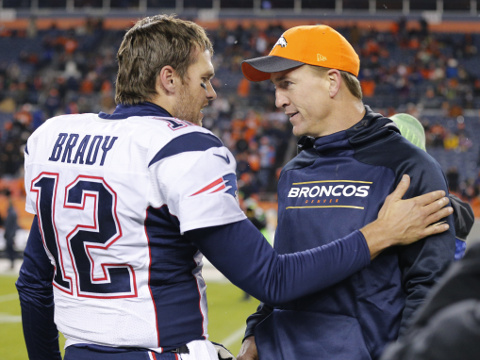
Tom Brady and Peyton Manning are matched up against one another again on Sunday in what is being referred to as Brady-Manning 17. Brady is leading the series 11-5, but more recently the matchup has been more balanced, with the last 10 matchups yielding a 5-5 record. Brady, of course, is perhaps the most decorated quarterback in the history of the NFL, amassing 6 Super Bowl appearances, winning 4. Manning, while only having won one Super Bowl, is the NFL’s all-time leader in passing yards and touchdowns. The two titans of the quarterback position meet in this year’s AFC Championship game for what many anticipate as the final showdown.
While the matchup has been marketed for the perceived contrasts between the two players, they share more similarities than differences. For starters, they share an uncanny competitive drive. Brady is the more outward in his displays of emotion, but Manning has the eyes of someone not to be crossed, and makes up for his lack of outward displays with the hours he spends studying and preparing for each game.
The truest similarity between Tom Brady and Peyton Manning, though, is in how adaptable they have been throughout their careers. Both have missed time with significant injuries, Brady overcoming knee damage and Manning overcoming neck and shoulder problems. They have also proven that they can throw touchdowns to just about anyone, as both have had close to 50 different receivers catch one of their touchdowns.
But perhaps the greatest mark of their adaptability has been showcased by Manning during the course of this year’s run to the playoffs. Manning’s Broncos began the year under heavy scrutiny, as observers questioned Manning’s arm strength. Through it all, the Broncos managed to keep winning, and when Manning succumbed to a mid-season injury, they continued to win under backup Brock Osweiller. Manning has recovered from his most recent injury, plantar fasciitis, enough to take the reigns back from Osweiller and resume his role as leader of the Broncos offense.
The Peyton Manning we are now watching, though, is a completely different quarterback than the gunslinger of yesteryear we all remember, the one who stood at the line yelling “Omaha”, scanning the opposing defense, finding weaknesses, then snapping the ball and delivering precision darts to open receivers. Gone is the touchdown-machine, replaced with the game-manager. Manning said as much after the Broncos victory last weekend against the Pittsburgh Steelers, pointing out his defense’s rise to become one of the most feared in the league. That defense is now the strength of the team, with Manning and the offense trying to do just enough to put them ahead, staying away from making costly mistakes. Whereas in days past we might have seen Manning throw 2 or 3 interceptions along with 3 or 4 touchdowns, now Manning strives for no turnovers and just a few, well-timed touchdowns.
Tom Brady has had to adapt too. While he is slightly younger than Manning and can still rely on his arm strength, he has had to face a far different challenge this year: learning how to win with a myriad of moving parts around him. His offensive line has been the subject of scrutiny all year, while his receiving corps was decimated by injury, only now returning to health. Brady’s ability to maximize the weapons around him is one of his most potent talents, and has allowed the Patriots to maintain their winning pedigree even with significant injuries.
Being adaptable is really a two part process, and most of the time we fail at the first part. To adapt, you have to first recognize and accept that your current situation is different than what you had thought it would be. Only then can you seek to change your behavior. While it is indeed difficult to change behavior, sometimes the hardest part is coming to grips with the different set of circumstances you find yourself in and accepting that things are not the way you wish. Manning surely wishes he had his old arm strength back, but he doesn’t, and he has to accept that. Brady would love to have all his teammates at full-strength, but they aren’t, so he has to accept their limitations.
In our lives of faith, we often struggle to grow because we don’t like the circumstances we find ourselves in. But our ability to open our hearts to receive what God wants to teach us and show us in these situations is the only way we’ll be able to move forward without becoming resentful or angry. Being adaptable and learning to grow doesn’t start with changing behavior, but with opening your heart in humility and receptivity to God.












